 NASA photo of the Çöllolar lignite mine wall failures, which took place in 2011. The major failure on the
NASA photo of the Çöllolar lignite mine wall failures, which took place in 2011. The major failure on the
northeast
side of the pit was the second within a week; the failure zone extended some 350 m beyond
the existing pit perimeter.
Kislaköy, on the right side of the image, reportedly suffered a pit-wall failure
in 2006..
In case anyone might have thought otherwise,
the fact that the last time E&MJ
provided an in-depth review of pit-wall
monitoring systems appeared shortly
after the massive wall failure at Bingham
Canyon was pure coincidence. The
coverage of the April 10 event in the
May 2013 edition, including a news
report (p. 4) and in the article itself on
pp.32-41, highlighted the precautions
that Kennecott Utah Copper had taken
to monitor the area of concern. As a result,
the company was prepared for the
slide, most of the major equipment was
withdrawn and nobody got hurt. Had appropriate
monitoring systems not been
in place, the consequences would have
been unimaginable.
Fortunately, wall failures of that magnitude
are rare, although smaller events
emanating from rock-mass movements
on localized discontinuities occur on a
fairly regular basis. Hence the need for
the increasingly sophisticated monitoring
systems that use optical, radar and microseismic
scanning techniques to check
whether wall and bench stability is in any
way being compromised over time.
An Industry-wide Challenge
A quick internet trawl illustrates just how
often surface mines are affected by wall
failures, although most are by no means
as severe as the Bingham Canyon event.
In March, Glencore subsidiary Katanga
Mining reported a wall collapse at its KOV
open pit in the Democratic Republic of
Congo (DRC). While ore production was
suspended there for economic reasons
last September, the company was maintaining
its pit dewatering program; the
wall failure left seven people dead and
damaged the dewatering infrastructure.
Another recent example occurred at
the Ok Tedi copper mine in Papua New
Guinea. In June 2015, a wall failure resulted
in a large amount of debris sliding
down into the pit bottom. Ok Tedi Mining
Ltd. CEO Peter Graham later told news
media in Australia that fallen rock had
damaged a hydraulic excavator and restricted
access to some higher-grade ore.
And this was not the fi rst time that
Ok Tedi had experienced wall instability.
As an article posted in June 2015 in the
AusIMM Bulletin by Robert Parker and
co-authors explained, the high rainfall
environment in which the mine is located
has led to the formation of major erosion-
related chasms from earlier minor
rock-slope failures. Measuring up to 240
m high and 220 m wide, controlling the
growth of these chasms has required signifi
cant engineering input.
As the authors noted, “The remedial
efforts included sophisticated ground
control monitoring, establishment of new
access ramps down the slope face, construction
of new drains for the diversion of
surface water runoff away from the chasm
footprint, ground stabilization, and chasm
crest, toe and slope face dewatering.
“All of this remedial activity had to be
accommodated within the daily framework
of other pit mining activity and completed
in often extremely poor weather conditions,”
they added. The challenge continued:
a localized wall failure at the mine in
March cost the life of one employee.
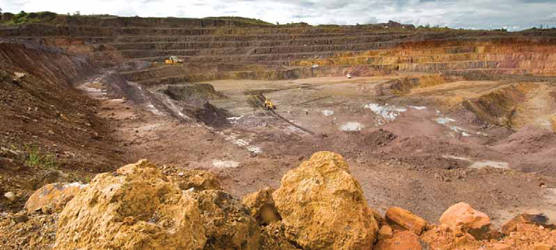 The Musonoie-T17 pit at Katanga Mining’s operations in the DRC. The company’s main KOV pit suffered a wall failure earlier this year.
The Musonoie-T17 pit at Katanga Mining’s operations in the DRC. The company’s main KOV pit suffered a wall failure earlier this year.
Neither is it the case that metal mines
are especially susceptible to wall failures.
Surface coal mines offer their own roster of
highwall incidents, often associated with
the interaction of discontinuities in what
are essentially weaker waste rock beds, together
with in-situ groundwater pressure.
Even NASA has recorded the results for its
Earth Observatory website, with an image
of the 2011 collapses at the Çöllolar lignite
mine in central Turkey. Occurring just
four days apart, wall failures on opposite
sides of the pit reportedly fl ooded some 50
million metic tons (mt) of material across
the workings, costing 11 lives in all.
Laser Scanning and Software
Exhibited at this year’s Hillhead quarrying
open-air exhibition in the U.K., Renishaw’s
Quarryman Pro system can be used in a
variety of ways in both quarries and openpit
operations—including regular profiling
of pit walls to check for displacement.
According to the company, Quarryman
Pro is a 3-D long-range laser-scanning
system that can easily be operated by one
person. Little training is needed to use
it and the associated, intuitive software.
Tripod-mounted, it is light, portable, and
can quickly be moved around.
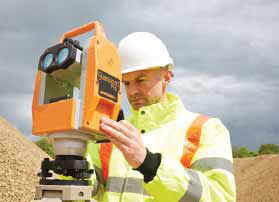 Renishaw’s QuarryMan Pro system is highly portable,
and can be
Renishaw’s QuarryMan Pro system is highly portable,
and can be
set to operate both automatically and manually
to scan pit wall faces.
Operators can choose between a manual
point-and-shoot mode, and an automatic
laser-scanning mode that covers
250 points per second. Entire rock faces
can be scanned in minutes, Renishaw
stated, with Quarryman Pro measuring
and recording millions of data points directly
to a USB drive. In consequence,
the system does not require external
PDAs or computers in the field.
The collected data can then be processed
to create detailed 3-D models for
editing, analysis, and export to specialist
packages or other CAD software. Data can
also be integrated with LiDAR data collected
from mobile mapping systems.
Two versions are available, with the
short-range system capable of measuring
distances up to 750 m. The long-range
version increases this to 1,200 m, and includes
optics that are designed and optimized
to provide improved results against
coal and other dark materials.
Renishaw has also upgraded the software
package for use with its Quarryman
Pro laser scanners. QuarrymanViewer has
a new, intuitive feel that makes workfl ow
quicker for operators, with new visuals
that provide clearer viewing and quicker
data interpretation. It also offers automated
point coding, traverse processing
and surfacing of single scans, while user
preference options mean that the system
stores most commonly completed functions,
making it quicker to repeat them
for future projects.
Geosynthetic Stability Solution
Although not strictly involved in slope
monitoring, Presto Geosystems offers
solutions that can help in stabilizing pit
and embankment walls in the event that
localized failures may occur. The company’s
Geoweb geocell system allows slopes
to be designed steeper than when infi ll
is unconfi ned, as well as supporting sustainable
vegetation that provides greater
protection against erosion—and thus
slope failure. In addition, Presto pointed
out, stable embankments create safer
work areas in open-pit mines, potentially
increasing the mineable area.
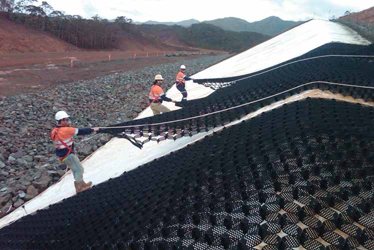 Installing Presto Geosystems’ Geoweb cellular slope reinforcement at Vale’s Goro nickel
Installing Presto Geosystems’ Geoweb cellular slope reinforcement at Vale’s Goro nickel
mine in New Caledonia.
Reclaiming and protecting embankments
can present challenges that include
stabilizing steep slopes, sourcing
fi ll, and working with diffi cult site access
and terrain. The Geoweb system consists
of 3-D confi nement material that stabilizes
embankments and prevents erosion on
steep slopes. It is a flexible solution that
can utilize many infi ll types, including
topsoil/vegetation, aggregate and concrete
for hard-armor protection. When used in
mining applications, the system can accommodate
on-site waste rock for fill.
The company’s chief design engineer,
Bryan Wedin, told E&MJ about a recent
project it had undertaken at Goro Nickel in
New Caledonia. Wedin explained that signifi
cant cut-and-fi ll work is required to protect
the civil infrastructure from erosion,
limit maintenance and to keep the mobility
of mine materials fully operational.
While large riprap, concrete and soil
cement had been used in the past for
erosion control, Geoweb offered the advantages
of lower costs, little or no maintenance,
and the use of local labor and
materials, while having a design life of
more than 50 years.
Just weeks after project completion, a
tropical cyclone hit New Caledonia with
600 mm (24 in.) of rain in 24 hours. One
day later, a magnitude 7 earthquake hit
nearby, and while these two events tested
the geosynthetic-reinforced embankment
to the extreme, even the steepest slopes
showed little or no erosion or sliding,
Wedin said.
Geocells are honeycomb-like structures,
manufactured from high-density
polyethylene, that confi ne and stabilize
infi ll materials. Several cell sizes and
depths are available to meet project and
application requirements, Presto noted,
the company having been marketing Geoweb
since the early 1980s.
Real-time Monitoring With Radar
A division of Reutech Ltd.—which has its
roots in the defense sector—South Africa-
based Reutech Mining produces the
Movement and Surveying Radar (MSR)
series of products. “We focus our product
development efforts around the key factors
that are critical to the success of any
slope-monitoring program,” said Alex Pienaar,
the company’s regional marketing
and sales manager. “The MSR improves
dynamic decision-making, aids in mine
design optimization, and enhances situational
awareness through highly accurate
radar data.”
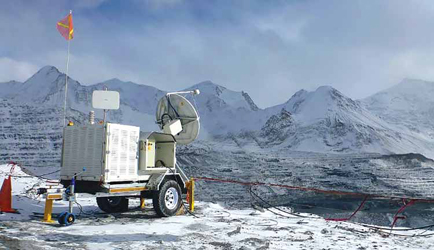 Built by a company with its roots in the military defense industry, the MSR Standard series can operate
Built by a company with its roots in the military defense industry, the MSR Standard series can operate
to temperatures
as low as -50°C without requiring external heating blankets or enclosures.
According to Pienaar, with optimized
on-board signal processing and highspeed
wireless communication capabilities,
the MSR delivers geotechnical data
and alarming functionality in real time.
This translates to a comprehensive understanding
of slope stability performance
in an environment where dynamic decision-
making ensures improved safety and
increased productivity, he told E&MJ.
Reutech believes that because an initial
pit design contains a variety of unknowns,
the back analysis of past failures
becomes imperative. With the MSR’s
advanced data-handling and storage capabilities,
3-D geo-referenced movement
and surveying data can be exported to a
variety of third-party mine planning software
packages. This means the slope design
can be constantly optimized as new
knowledge of the underlying mechanics
at play is unearthed.
An integrated slope-monitoring program
improves safety and increases productivity,
the company claims. With the
MSR, radar data along with 3-D vector
data from automatic total stations and
extensometers are displayed on the same
interface—in real time, so users can rapidly
identify changing slope conditions
and make better-informed decisions.
Pienaar explained that since it can
uniquely resolve multiple points within
a single beam, the MSR delivers a
high-quality self-generated point cloud
without relying on additional third-party
mechanisms. That means that the MSR
can be used for permanent stability monitoring
as well as the ad hoc monitoring
or surveying of other areas such as waste
dumps or tailings dams. The result is a
product that offers unrivaled fl exibility
and functionality within any mining operation,
he said.
Hexagon Offers Several Options
Hexagon Mining told E&MJ it connects
planning, operations, geodetic slope monitoring,
surveying, UAV and radar-based
monitoring systems to provide a holistic
view of a mine. Highly fl exible automatic
deformation monitoring is available via
Leica GeoMoS, which monitors prisms
with an automated TM50 total station,
slopes, and structures with the MS60
combined laser scanner and total station,
and standalone GNSS sensors to enable
slope monitoring.
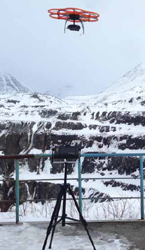 Hexagon’s Aibot multicopter UAV
Hexagon’s Aibot multicopter UAV
is just one facet of the
company’s
range of slope stability monitoring
systems.
Automated motorized total stations
and GNSS technology are pivotal to risk
management in mining high walls, tailings
dams and other critical structures.
GeoMoS can also combine any geotechnical,
meteorological, hydrological or other
sensors into its analysis and dashboard
platform, correlating all pertinent data
into one location. Complementing Geo-
MoS are the IBIS radar systems from
IDS GeoRadar (see below), which Hexagon
Geosystems acquired from its parent
company earlier this year.
Hexagon said its UAV offerings—the
Aibot X6 multicopter, Leica Delta FW70
fi xed wing and Swiss Drones’ Dragon 50
helicopter—add a new perspective to pit
slope analysis and monitoring. Scaling
highwalls and traversing pits with ease,
these allow mines to visualize and survey
previously inaccessible areas safely and
quickly, removing blind spots that fi xed
location scans cannot achieve. Bringing
these data into the 3DReshaper software
allows rapid processing, fi ltering and
analysis of the point clouds for terrain
change detection and design versus asbuilt
inspection.
Hexagon Mining’s partnership with
Austrian company Riegl brings its customers
access to leading-edge laser scanning
technology for long-range surveying
and monitoring applications. The Riegl
VZ-4000, for instance, is a terrestrial
long-range scanner boasting a range of up
to 4 km. It is very compact, fully portable,
and delivers highly accurate 3-D data
rapidly and effi ciently, the company said.
Combined with RiMonitor software, the
Riegl system delivers automated periodic
scanning, change detection analysis and
user-defined alerts.
Point cloud data from UAVs and laser
scanners can now be loaded and viewed
in Hexagon Mining’s MineSight planning
suite. Development is under way to bring
GeoMoS 3D movement vectors and IBIS
GeoRadar displacement maps into Mine-
Sight 3D as live objects so that engineers
can assess the stability of pit walls when
creating mine plans.
Monitoring for Movement in Turkey
According to Niccolò Coli, Mining Business
Unit manager at IDS GeoRadar, the
company’s IBIS system is the fi rst Synthetic
Aperture Radar (SAR) developed
and designed specifi cally for real-time
monitoring of mine walls. “The IBIS technology
has been a game-changer for slope
monitoring on account of its superior performances
for safety-critical monitoring
and the capability to provide extra information
in support of geotechnical analysis
and mine planning,” he said. “That
makes IBIS systems a geotechnical tool
suitable for both strategic and tactical
monitoring, with IBIS radars able to provide
full-scale coverage from both spatial
and temporal perspectives.”
 The IBIS-Rover from IDS GeoRadar offers mobile radar
The IBIS-Rover from IDS GeoRadar offers mobile radar
monitoring.
IDS GeoRadar stated that its radars
provide a complete solution for mine slope
monitoring with the IBIS-FM providing a
range of up to 4.5 km, and IBIS-Rover (a
short-range [2 km], broad area coverage
system with digital terrain model-creation
capabilities) used when frequent relocation
is required. The company also claims
that it is the only radar supplier providing
complete integration; with the advanced
FPM360 platform, the user is provided
with a real-time universal view of the pit
by stitching together multiple IBIS radar
datasets in a single view.
With the recent introduction of IBIS
Guardian TrueVector, IDS GeoRadar said
it has set a new standard, by enabling the
integration of multiple IBIS radar units
to resolve the spatial displacement vector
over the monitored area with submillimetric
accuracy. No prisms or markers
are needed on the slope.
The system also offers fully automated
integration with TPS and GNSS datasets
(Leica GeoMoS and Trimble T4D), allowing
users to plot in real-time displacement
trends from geodetic monitoring
systems against the radar data. Stereonet
charts are also available in support of geotechnical
analysis.
As an example of an IDS GeoRadar
system in operation, the company told
E&MJ that, since February, a gold mine
in Turkey has been using an IBIS-Rover
to cover a number of critical pit-wall areas.
The radar unit can cover 180° with
a two-minute scan time and sub-bench
resolution at a distance of up to 1,100 m.
The operation has complex geometry
with two small adjacent pits connected
by a pushback. The IBIS-Rover covers
the main areas of geotechnical concern:
immediately after deployment, the radar
picked up two previously identifi ed major
moving areas, with the high detail defi nition
provided by the radar map providing
good delineation of their extension.
An enhanced algorithm for automatic
atmospheric removal provides extremely
high data quality, IDS GeoRadar stated,
with the entire dataset being unaffected by
massive accumulations of snow in the pit.
Extensometers Offer Cost-effective Monitoring
Available since 2003 from the U.S. geotechnical
consulting fi rm, Call & Nicholas
(C&N), the SlideMinder slope monitoring
and warning system is marketed as a
user-friendly method of gathering highly
accurate slope monitoring data for engineering
and safety purposes. The remote
system uses reliable wireline extensometer
technology and software to create
a graphical data presentation, calculate
velocity, and issue warnings based on user-
defined parameters.
C&N’s operations manager, Joe Foster,
said a SlideMinder system uses at
least one deployed wireline extensometer
(a SlideMinder), which reports measured
displacement back to a base station server
via radio or the local Wi-Fi network.
Each extensometer is deployed to an
area of concern. The wireline is then run
out and anchored to the moving ground
or slope. As the slide propagates, the displacement
is measured by a highly sensitive
encoder in the SlideMinder, then
relayed to the server for data analysis
and collection.
SlideMinders are designed to require
minimal maintenance once deployed.
Each unit is self-powered using a 10-
watt solar panel and storage battery, and
is equipped with a warning strobe and a
rain gauge. According to Foster, C&N has
customers that, due to inclement weather
and distance, cannot easily access their
units for months at a time but the Slide-
Minders report their data consistently.
The other side of the system is the
OREAD (Observation, Recording, Evaluation
and Administrative Database) server
software, where collected data are stored
and observed. Here the user can graph
displacement, velocity, inverse velocity,
precipitation and temperature data for
each deployed unit. OREAD will also
send out emails and texts, activate warning
devices based on alarms determined
by the local engineers and geologists,
and can be accessed remotely.
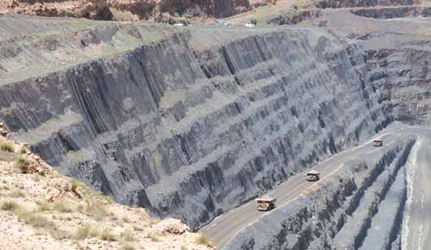 Mesh installed on pit walls can lead to erroneous readings from some monitoring systems—a problem 3D
Mesh installed on pit walls can lead to erroneous readings from some monitoring systems—a problem 3D
Laser
Mapping claims to have overcome with its 4DSiteMonitor.
The company now has SlideMinder
units working in the USA, Canada, Mexico,
Peru, Chile, Papua New Guinea, Indonesia,
Australia, the DRC and Argentina,
with distributors covering Australasia,
South Africa (Reutech) and Latin America.
Measuring Through Mesh
SiteMonitor4D from 3D Laser Mapping,
the geospatial technology supplier, is an
automatic, remote laser-based measurement
system that permits hazardous or
inaccessible areas to be safely monitored.
This is achieved through a high-accuracy,
automated, long-range monitoring system
that has the fl exibility and performance to
function in a wide range of applications,
the company said.
SiteMonitor4D captures repeat, timeseries
laser measurements that are used
to generate highly detailed 3-D displacement
maps of the surface under investigation.
The data displayed can be used
to indicate imminent failure and other
custom set alarm criteria. In addition, the
data can be used not only to identify and
monitor any acceleration in movements
that often occur as a precursor to large
scale failures, but to understand the failure
mechanics and determine effective
future mitigation techniques.
The system can be used to provide
either automatic (continuous) or periodic
data capture, with wizard-based setup
that allows personalized monitoring
schedules. Resolution settings, window
size and the frequency of scans can be
defi ned on a case-by-case basis, with the
possibility of setting up additional monitoring
for “hot spots.”
Data analysis permits displacements
to be tracked through time, and results
to be correlated with external data sets.
It is also possible to carry out geotechnical
analyses to understand displacement
styles, while alarm settings can be included
to mitigate against failure in real time.
As the company pointed out, the use
of wire mesh or safety netting can often
limit the ability to capture detailed measurements
of a rock surface, resulting in
poor or inaccurate information regarding
the movement of the slope. When steeply
sloping rock faces fragment and release
rock debris, close fi tting wire mesh and
netting is often anchored to the slope
face. Vegetation can take root and cause
an obstruction to systems trying to measure
movement on the slope face itself.
SiteMonitor4D can work around these
obstructions by using a unique function to
record multiple targets for each measurement.
This enables measurements of the
wire mesh (fi rst target) and the slope (last
target) to be returned, with the system automatically
applying fi ltering so that only
data from the slope face are analysed.
“SiteMonitor4D can resolve rock fall
accumulation and debris movement behind
the mesh, which can often indicate
slope instabilities, even on slopes with
more than 60% of their surface covered in
mesh,” said Dr. Sarah Owen, LiDAR systems
engineer at 3D Laser Mapping.
As featured in Womp 2016 Vol 08 - www.womp-int.com







